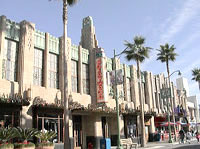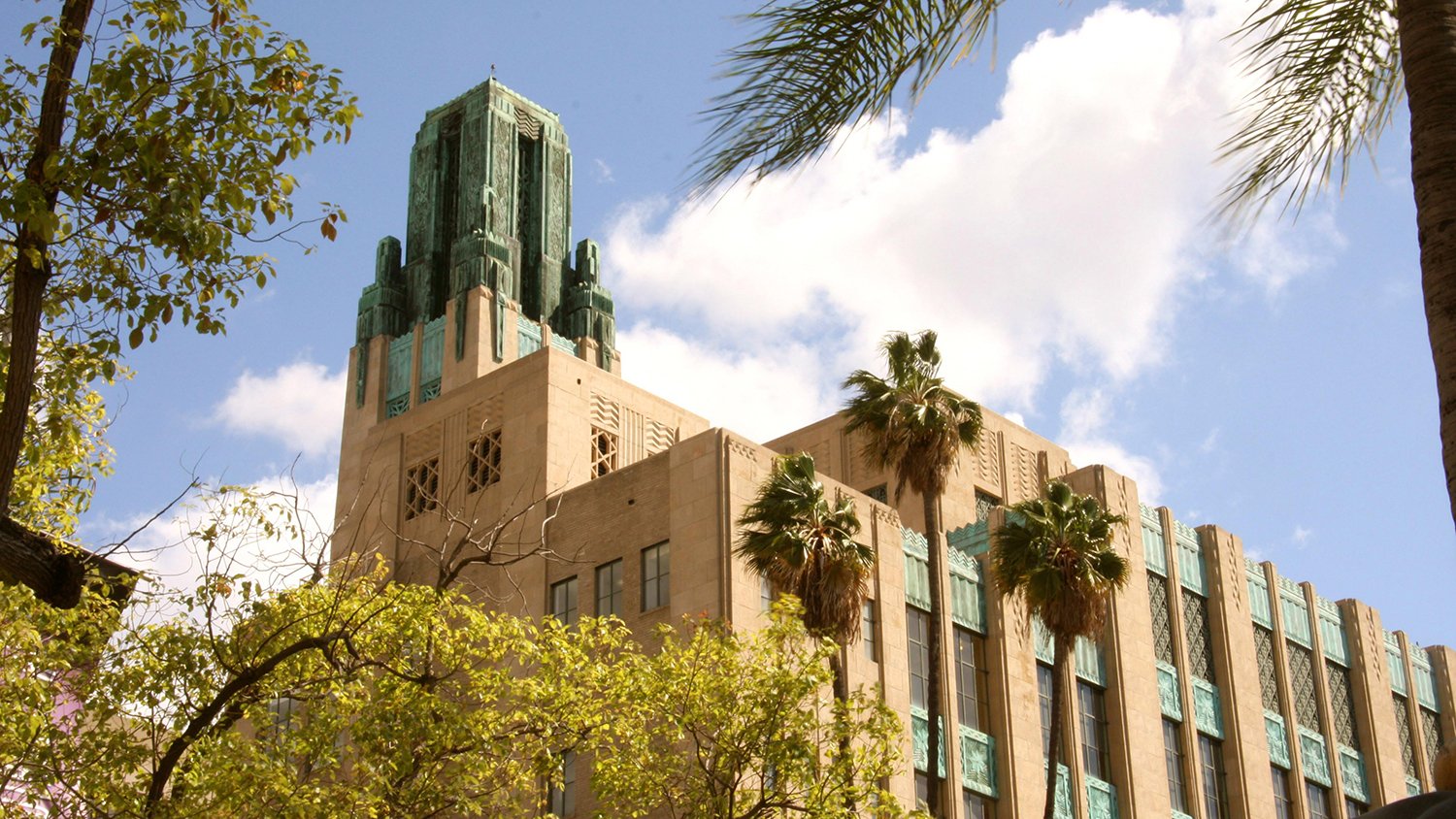History of Bullocks Wilshire
Steeped in the glamour of another era's rich and famous, the Bullocks Wilshire building is a stunning, masterly crafted Art Deco treasure that occupies a special place in Los Angeles history.
It was conceived by business partners John G. Bullock and P.G. Winnett to house the upscale Bullocks Wilshire Department Store. But while the building’s function was an ordinary one, its creators had grand ambitions for its design.
After visiting the 1925 Exposition of Decorative and Modern Arts in Paris, where the art deco, or moderne, style was introduced, Winnett and architect Donald Parkinson agreed to use this new aesthetic as the inspiration for the department store. When it opened in 1929, the building was one of the first Art Deco structures built in the United States.
Parkinson—who, along with his son John, went on to design some of Los Angeles' leading landmarks, including Union Station and City Hall—created an elegant five-story structure that, even today, stands out in the skyline. The gleaming edifice was constructed with terra cotta-clad reinforced concrete and accented with green verdigris copper. While building codes at the time sought to cap structures at 150 feet, the architects found a loophole enabling them to erect the Bullocks Wilshire building at 241 feet.
Like the German Bauhaus School of Design, Art Deco combines function and beauty, and embraces contrasts among geometric shapes, vibrant colors, and exotic materials. Abstractions from nature combine with forms common to machinery. Most of all, Art Deco celebrates the modern age. In the 1920's mass production techniques, technology, and new modes of travel were rapidly changing the way people lived, and they influenced Art Deco design. This celebration of the modern age greets visitors arriving at the Bullocks Wilshire entrance where one can admire the magnificent dry fresco, The Spirit of Transportation. Painted by Herman Sachs, the Spirit of Transportation celebrates all modes of transportation common to the era except the car: flight, rail, ocean liner, and the great dirigibles.
The Bullocks Wilshire building, and its beautifully appointed penthouse Tea Room, regularly drew Hollywood elites such as John Wayne, Greta Garbo, Alfred Hitchcock, Marlene Dietrich, Clark Gable, and Mae West, as well as residents of the wealthy surrounding communities of Hancock Park, Windsor Square and Fremont Place. This gilded clientele helped the store survive the Great Depression, which began a month after its opening—a grand affair that drew 300,000 people.
For more than 60 years, the name Bullocks Wilshire was synonymous with elegance and style. However, over the years, many of the building's prized architectural features were covered or removed. In 1969, local officials recognized the structure’s unique place in architectural and civic history by naming it a Los Angeles Historic-Cultural Monument. Nine years later, it took its place on the National Register of Historic Places.
Business Declines, Southwestern Steps In
Eventually, business at Bullocks Wilshire took a downfall, as malls moved into suburbia, shopping habits and merchandising changed, and high-end stores opened farther west. In the 1980s, after a dispute among its directors, the store was sold to Federated Department Stores. Macy's later purchased the business, but in 1993 the company filed for bankruptcy. The store was closed permanently, marking the end of an era and generating serious concern for the future of one of the city's most beautiful and beloved buildings.
That changed in 1994 when Southwestern purchased the building in bankruptcy proceedings. Founded in 1911, Southwestern had been housed in a structure across the street from the Bullocks Wilshire since the mid-1970s. While it was in great need of additional space to accommodate its burgeoning law library and other facilities, the law school had not initially intended to buy the property. Plans were in the works to construct an addition to the existing building, and finances had already been set aside. Fortunately, development had not yet begun when the Bullocks Wilshire became available, and Southwestern acquired the property.
Rebirth of a Treasure
Over the next ten years, Southwestern meticulously restored the Bullocks Wilshire building to its original luster and design. Drawing from original plans, archival photos, and other historic documents, the law school refurbished or reproduced the property's distinctive colors, decor, and other details, while adapting the building to serve as a dynamic academic facility.
In October 1997, a black-tie gala was held to celebrate the opening of Southwestern's exquisite, 83,000-square-foot law library in the Bullocks Wilshire building. Members of the California Supreme Court, federal courts and other distinguished judicial officers, elected officials, and prominent members of the legal and business communities were among those in attendance.
The next several years saw the conversion of the Tea Room into a dining and gathering area, and the construction of new conference and seminar rooms, and faculty and administrative offices. A second gala was held in October 2004 to celebrate the opening of the Julian C. Dixon Courtroom and Advocacy Center, which marked the completion of the Bullocks Wilshire building’s $29 million renovations.
Southwestern has received numerous awards for its sensitive restoration and adaptive reuse of the structure, including the 2005 President's Award from the Los Angeles Conservancy, 2000 National Preservation Award from the National Trust for Historic Preservation, and the Governor's Historic Preservation Award from the California Office of Historic Preservation.
Today, the Bullocks Wilshire is the heart of the Southwestern campus—a shining example of the school’s thoughtful and determined effort to raise the bar for legal education.
- Architectural Awards
Since 1997, a series of honors and awards have been showered on Southwestern for its restoration and adaptive reuse of the historic Bullocks Wilshire Building. These include:
- 2005 Los Angeles Conservancy President’s Award "for showing true vision in integrating the former Bullocks Wilshire department store into its campus expansion plan ... and for meticulously restoring and transforming the beloved Los Angeles landmark into a unique, state-of-the-art learning environment and model of adaptive reuse."
- 2002 Design Award for Excellence - Concrete Reinforcing Steel Institute (for Campus Entry and Parking Ramp)
- 2000 National Preservation Award - one of only 16 awarded to projects across the country by the National Trust for Historic Preservation
- Save Americas Treasures Campaign - Selected as an official project of the Campaign, which was sponsored by the National Trust for Historic Preservation and the White House Millennium Council
- California Office of Historic Preservation - Governor’s Historic Preservation Award
- Cultural Heritage Commission of Los Angeles - City of Los Angeles Historic Preservation Award for Excellence in the Institutional/Religious category
- Associated Builders and Contractors - Award of Excellence for Historical Restoration
- Los Angeles Business Council - Urban Architectural Award in the Remodeled Public Use/Institutional category
- Los Angeles Headquarters Association - Cultural Award (for historic restoration/renovation)
- Windsor Square - Hancock Park Historical Society - Respectful Renovation Award
- The Downtown Breakfast Club - Annual Rose Award (for excellence in renovation)
Southwestern Meets Disney in Theme Park
 With the opening of Disney's California Adventure in February 2001, Southwestern has achieved a unique new distinction: It's the only law school with a building replicated in a theme park. Located in the art-deco-inspired Hollywood Pictures Backlot section of the new park, the Bullocks Wilshire building joins other familiar Los Angeles icons in celebrating the glamour of Tinsel Town.
With the opening of Disney's California Adventure in February 2001, Southwestern has achieved a unique new distinction: It's the only law school with a building replicated in a theme park. Located in the art-deco-inspired Hollywood Pictures Backlot section of the new park, the Bullocks Wilshire building joins other familiar Los Angeles icons in celebrating the glamour of Tinsel Town.
Southwestern's Bullocks Wilshire Building: One of Los Angeles' Living Museums
In October of 2005, the Los Angeles Conservancy launched a program to showcase the history of Wilshire Boulevard through an educational initiative called Curating the City. This program, running the length of Wilshire Boulevard—from downtown to the ocean—featured the Bullocks Wilshire building as one of its many exhibits.
The program included a one-day, self-guided architectural tour of Wilshire Blvd. and was accompanied by a trilingual guidebook (in English, Korean, and Spanish). The Bullocks Wilshire building was one of at least six sites open for docent-led tours, representing different eras, architects, and icons of the boulevard. Other features of the program included a kid’s activity guidebook, family-friendly activities, and online resources for teachers and families to use the city as a fun learning environment; a permanent website; a series of exciting events presented in conjunction with local cultural, community, and educational organizations; and bus advertisements that offered historical images and information about several of the architectural gems along the Wilshire route, similar to the labels accompanying objects in a museum.
On the Air and in Print
The restoration of the historic building and the opening of the Law Library have been featured in print, radio, and television coverage, both locally and nationally, including three hour-long episodes of the Public Television program Visiting with Huell Howser. Howser's programs focused first on the closing of the store and Tea Room, then the restoration and adaptation of one-third of the building to accommodate the Law Library, and finally, the reopening of the Tea Room to serve Southwestern students, faculty, and visitors.
In addition to many articles in the Los Angeles Times, stories on the Library appeared in the Los Angeles Times Magazine, the New York Times (cover story of "The Living Arts" section), and local and legal newspapers around California. It was the cover feature in the July 1997 issue of Interiors magazine, and was also presented in the December 1997 Architectural Issue of Library Journal, and the April 1998 Facilities Showcase Issue of American Libraries, among other publications. Southwestern's efforts have also been recounted in the final chapter of of alumna Margaret Leslie Davis' book Bullocks Wilshire, published by Balcony Press, 1996. The building has also been featured in movies and commercials.
Photos courtesy of the California History Room, California State Library, Sacramento, California.
